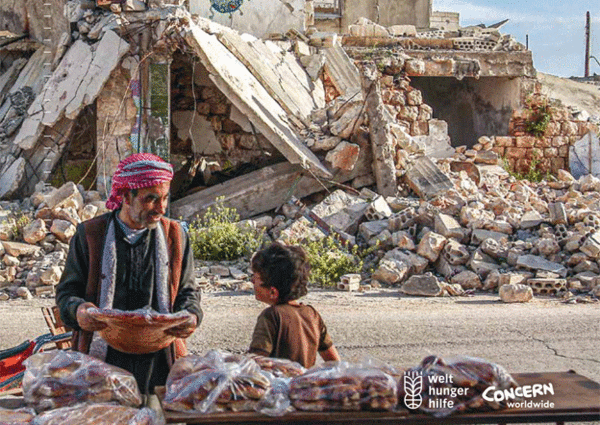 Read this article in French
Read this article in French- Share this article
- Subscribe to our newsletter
Global Hunger Index 2021 paints gloomy picture
World-wide, up to 811 million people are suffering chronic hunger, while 155 million people are experiencing an acute food crisis – almost 20 million more than last year. The global community is moving further and further away from the goal of eliminating hunger by 2030. In fact, the UN Food and Agriculture Organization estimates that by that year, around 657 million people will be undernourished, which represents about 8 per cent of the world population. “Unfortunately, our worst fears last year have been confirmed. Famines are back, and multiple crises are causing the number of those going hungry to rise further and further,” said Welthungerhilfe Secretary General Mathias Mogge, presenting the Global Hunger Index in Berlin/Germany in mid-October.
A toxic cocktail of climate crisis, corona pandemic and protracted violent conflicts
The corona pandemic has further aggravated the already tense food situation in many countries of the Global South. However, the biggest drivers of hunger continue to be climate change – as the example of the devastating drought in Southeast Madagascar is impressively demonstrating right now – and violent conflicts. More than half of all undernourished people live in countries marked by violence, conflict and fragility; 60 per cent of the people in these countries depend on agriculture.
But where there is war, the food systems are impaired at all levels. Fields and harvests are destroyed, roads are blocked, areas are mined, and markets no longer work. For fear of fighting and being attacked, people abandon their villages; often, their survival then depends on humanitarian aid. Yemen, Syria und Afghanistan are striking examples of this development. For example, according to the UNHCR, Afghanistan had nearly 3 million internally displaced people in late 2020, and since the beginning of this year, armed conflicts have turned more than 650,000 people into refugees in their own country.
Linking peacekeeping and food security, transforming food systems
It is also a known fact that food insecurity can contribute to violent conflict. Therefore, Welthungerhilfe calls for flexible, cross-sector financing models in international cooperation which focus more on the mutual effects of food security and peace. The right to food above all has to be asserted in the context of conflicts, too, the organisation demands. “Sanctions have to at last be consistently imposed on using hunger as a war weapon,” says Welthungerhilfe President Marlehn Thieme. In addition, a radical transformation of the existing food systems is needed to make them more resilient, Thieme maintains. For this purpose, the resolutions of the UN Food Systems Summit require a consistent follow-up. Thieme states that the Climate Summit (COP 26) in Glasgow/ Scotland in early November and the Nutrition for Growth (N4G) Conference in Tokyo/ Japan in early Decembre offer a good opportunity for this.
The Global Hunger Index (GHI) 2021 at a glance:
- The Global Hunger Index (GHI) categorises and ranks countries on a 100-point scale and breaks their hunger situation down into five categories: low, moderate, serious, alarming and extremely alarming.
- Of the 135 countries assessed, 19 did not have sufficient data to allow for the calculation of a 2021 GHI score, but provisional designations of the severity of hunger were assigned to 12 of those countries based on other published data.
- Africa South of the Sahara and South Asia are the world regions where hunger levels are highest. Hunger in both regions is considered serious.
- Hunger is at an alarming level in five countries – Central African Republic, Chad, Democratic Republic of the Congo, Madagascar, and Yemen – and is provisionally categorised as alarming in four additional countries – Burundi, Comoros, South Sudan, and Syria. One country, Somalia, suffers from an extremely alarming level of hunger.
- Hunger has been identified as serious in 31 countries and is provisionally categorised as serious in 6 additional countries.
- Since 2012, hunger has increased in ten countries with moderate, serious, or alarming hunger levels: Central African Republic, Republic of Congo, Ecuador, Lesotho, Madagascar, Malaysia, Oman, South Africa, Venezuela, and Yemen.
- Fourteen countries have achieved significant advances in the fight against hunger, with a reduction of 25 per cent or more between their 2012 and 2021 GHI scores, including Bangladesh and Mongolia.
- In eight out of ten countries with serious or alarming hunger levels, conflicts are significantly contributing to hunger. Madagascar is the only country with an alarming 2021 GHI score that is not experiencing conflict.
- Hunger and undernutrition tend to be higher in rural areas than in urban areas, but it is unclear how the COVID-19 pandemic will affect this dynamic in the long term.
- GHI scores are based on a formula that captures three dimensions of hunger – insufficient caloric intake (undernourishment), child undernutrition, and child mortality – using four component indicators:
- Undernourishment: the share of the population that is undernourished, reflecting insufficient caloric intake;
- Child wasting: the share of children under the age of five who are wasted (low weight-for-height), reflecting acute undernutrition;
- Child stunting: the share of children under the age of five who are stunted (low height-for-age), reflecting chronic under- nutrition;
- Child mortality: the mortality rate of children under the age of five.
(sri)
The Global Hunger Index 2021 is available in English, French, German, Italian, Portuguese, Spanish and Chinese.
Further reading: Global Hunger Index Website


